#pargalı ibrahim pasha
Text









#okan yalabık icons#okan yalabık#icons with psd#psd icons#pargalı ibrahim pasha#pargalı ibrahim pasha icons#tv series#tv series icons#magnificent century#magnificent century icons#muhteşem yüzyıl icons#muhteşem yüzyıl#actors#actors icons
2 notes
·
View notes
Text





-My Hatice...
+The other day, you reminded me of a letter. The first letter you wrote to me. This one. I still keep it.
-Time flies fast.
+And I keep your last letter as well. "My Sultan, if your wish is to divorce me, do not wait! You could not hurt me, even if you kill me. Because... I do not regret my actions. Long ago for your love, I left everything behind and went to Parga. I can do the same and start a new life."
-Hatice...
+I want you to burn this letter Ibrahim. Burn it, now. I want everything you told me to become ash with this letter. Then I'll forget the past and put on that ring. Ibrahim, if you burn this letter I'll forget about it all. For us. For our children. And we'll start a new life.
#hatice the sultan of betting on losing dogs#rip hatice you would love crying to mitski songs#name a more iconic duo than me and failmarriages#mc posting on main#magnificent century#muhteşem yüzyıl#hatice sultan#hatice sultana#ibrahim pasha#İbrahim paşa#pargalı ibrahim#mitski#don't know what this is#web weaving#ig?#mc#ibrahim of parga#sad girl hours
11 notes
·
View notes
Text

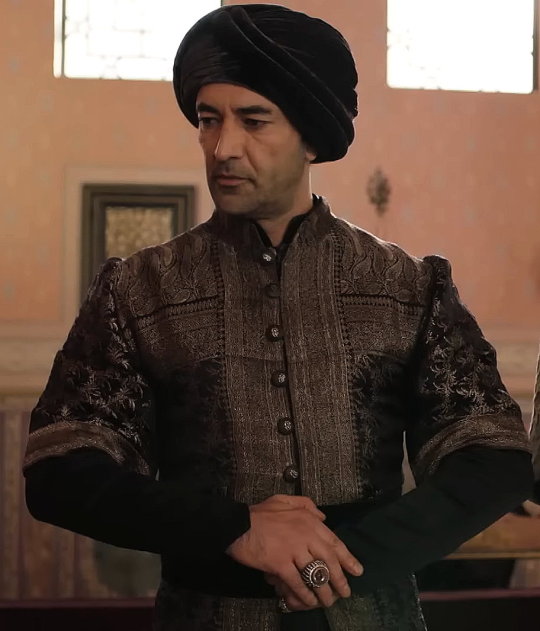
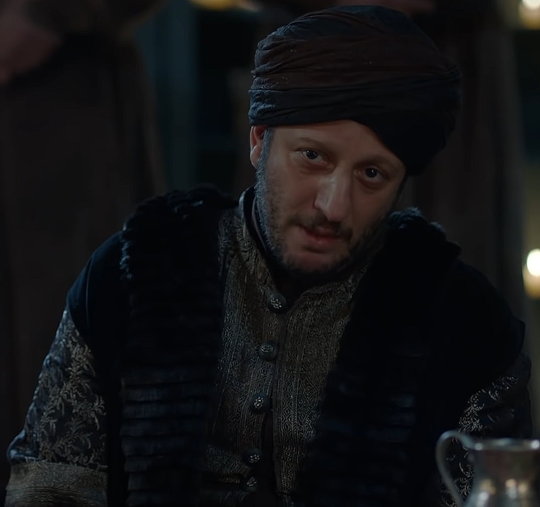
This black and golden kaftan was first worn by Pargalı İbrahim Paşa in the twenty-third episode of the second season of Magnificent Century.
The kaftan appeared twice in Magnificent Century: Kösem. It was worn by Derviş Mehmed Paşa in the twelth episode of the first season as well as by Nef'i in the nineteenth episode of the second season.
#Muhteşem Yüzyıl#Muhteşem Yüzyıl: Kösem#Magnificent Century#Magnificient Century Kösem#Magnificent Century Kosem#period drama#costume drama#historical drama#Pargalı İbrahim Paşa#Ibrahim Pasha#Derviş Mehmed Paşa#Dervish Pasha#Nef'i#Nefi#reused costumes#recycled costumes
5 notes
·
View notes
Text
Byzantinists in Istanbul
Patricia Blessing, ANAMED Senior Fellow (2022–2023)
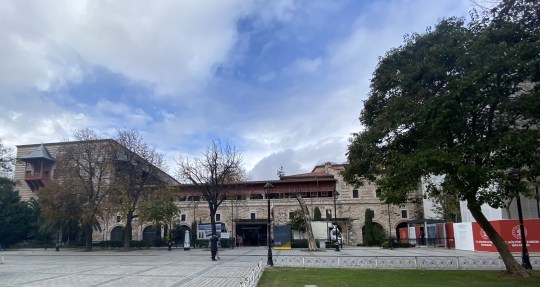
Figure 1: View of TİEM.
Today, the Byzantinist subgroup of the ANAMED fellows (which really is a loose grouping of scholars who either work on Byzantine topics or are otherwise interested in Byzantine Studies) went on a visit to the Museum of Turkish and Islamic Art (Türk ve İslam Eserleri Müzesi, hereafter TİEM).
TİEM is located on the Hippodrome, facing the Sultan Ahmed Mosque, in the İbrahim Pasha Palace (Figure 1), named thus because it was once the residence of Ottoman grand vizier Pargalı İbrahim Pasha (d. 1536). The museum is one of the locations where I have been conducting research for my project at ANAMED (Figure 2). TİEM has been in this location since 1983. Previously, since its foundation in 1914 (until 1927 under the name “Evkaf-ı İslamiye Müzesi”), it had been located in the imaret of the sixteenth-century Süleymaniye Mosque complex, as seen on the title page of a museum guide published in 1939 (Figure 3).

Figure 2: The author heading to a research appointment at TİEM in September 2022.

Figure 3: Title page of the 1939 TİEM guidebook.
Much of the collection consists of objects that were taken from former Ottoman lands or were already located in historical monuments within present-day Turkey and beyond. In the early twentieth century, in part because of increased looting to supply the European art market with Islamic objects then fashionable among collectors, objects were removed from monuments across the Ottoman Empire and put aside for the museum founded in 1914. The history of the museum is told in the catalog Türk ve İslam Eserleri Müzesi 100 Yıl Önce (Figure 4), published for the museum’s one-hundredth anniversary in 2014. The catalog shows records that document from where objects were removed at which dates, and also notes that some objects were exchanged with the collections of Topkapı Palace, which is effectively the historical art collection (containing everything from arms and armor to china and kaftans) of the Ottoman dynasty.

Figure 4: Türk ve İslam Eserleri Müzesi 100 Yıl Önce, 100 Yıl Sonra (Ankara, 2014).

Figure 5: Partial view of the room at TİEM holding Ottoman objects.
The museum is arranged partially chronologically, starting with early Islamic art, and partially by dynasties and geographies. Thus, dynasties of Iran and central Asia such as the Great Seljuks, Timurids, Safavids, and Qajars are arranged in chronological order in adjacent rooms. The exhibition culminates in two rooms dedicated to Anatolian Seljuk and Ottoman art (Figure 5), which form strong points of the collection. During our visit, we discussed different types of tile-making techniques in the Ottoman Empire, the issue of distinguishing “Byzantine” and “Islamic” ceramics in medieval Anatolia, and molded Seljuk ceramic vessels. We were also intrigued by the various types of lighting devices that were made for mosques: brass candlesticks that ranged from 25 to nearly 90 cm in height and held wax candles, transparent glass lamps with enameled and gilded decoration that held olive oil, and pierced metal lanterns are only some of the objects we saw and took as the starting point of a discussion of lighting in Byzantine and Islamic sacred buildings. Relatedly, the large carpet collection led to questions on the isolation and heating of rooms—in the İbrahim Pasha Palace, large fireplaces would have helped with heating and could have been the source for gleaming coals to be placed in portable braziers (Figure 6). Bidding farewell to the resident cats (Figure 7), we then went on to visits of the Cistern of Philoxenos (Binbirdirek Sarnıcı) and Topkapı Palace.

Figure 6: A fireplace in the İbrahim Pasha Palace.
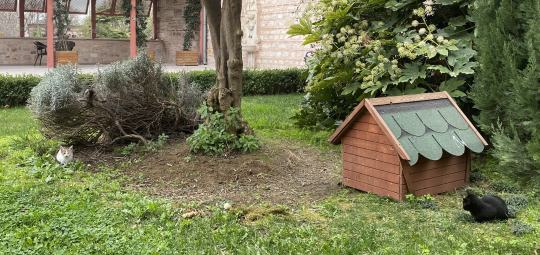
Figure 7: The youngest members of TİEM’s crew of resident cats.
0 notes
Text

Hurrem&Ibrahim scenes (5\?)
#muhteşem yüzyıl#magnificent century#meryem uzerli#okan yalabık#period drama#period costume#hurrem sultan#hürrem sultan#ibrahim pasha#ibrahim paşa#pargalı ibrahim#historical costume#historical drama#history drama#turkish tv shows#turkish tv series
97 notes
·
View notes
Photo






GIF REQUEST MEME | @musicalheart168 asked:
Magnificent Century + Favorite Location → Hatice and Ibrahim’s Palace
#magnificent century#muhtesem yuzyil#mcedit#perioddramaedit#hatice sultan#Pargalı Ibrahim Pasha#S2E36 Til Death Do Us Part#S1E17 The Double Joy#S2E49 Strengthening of the Positions#S2E51 Fateful Decision#mcs1#mcs2#gif request meme#requests#my edits
167 notes
·
View notes
Note
Continue roasting Pargalı he deserves it
Oh gladly!
I feel like Ibrahim and Matrakci Nasuh Efendi relationship isn’t stressed enough so I am gonna do it. Ibrahim took Matrakci for granted, if there is someone other than Hatice that genuinely cared about his well being then it is my man Matrakci. Matrakci protected him , guided him and served him and how our pasha paid him back with? He forced him to divorce Nigar and ruined his reputation with people cause everyone thought he was a horned cuckold. I don’t think Matrakci was head over heels for Nigar, but at the end he wanted a family and he wanted peace but his “best friend” cannot keep his 🍆 in his pants when it comes to Nigar. Still Matrakci after knowing that Hatice is suspicious of Ibrahim he immediately went to warn him.
He also took Nigar for granted. He knew she loved him and he was probably attracted to her sexually as well as that she satisfies his ego that’s why he used her. They are exposed and what he does to the woman that carries his upcoming child , the woman he promised her he will always love her? Nothing. He completely forgot that he was the one who went to her not the other way around. What he should’ve done after finding his daughter is to give her to Nigar and let them have a peaceful life somewhere. I understand he can’t let go his daughter that easily but so can’t Nigar,however, Ibrahim has Hatice and her children from him….Nigar has nothing at all and she suffered more than him in this scandal.
I would never say Ibrahim deserved to die but rather had it coming. He is that stupid to say he tames SS and claim that without him the empire would’ve fall when he knows there is a man that literally writes every word coming out of his mouth in a Daftar that SS could easily get access to! Plus his obvious support to Mustafa. Yup he might be faithful to SS but I suppose since he knew SS in his prince-hood then he definitely saw how Yavuz Selim dethroned his own father (SS grandfather) Bayezid II. SS is logically paranoid that he could end like his grandfather and the immense support Mustafa is getting is making him paranoid. If Ibrahim was smart he shouldn’t have been obvious with favoritism being a father figure to not just Mustafa but to all of SS children would’ve been better. When he went to Bursa to meet Mustafa and talk about Helena , he did it out of genuine love for Mustafa. The problem is that he lied to SS and made his paranoia grow more. Ibrahim’s secretiveness is also one of his downfalls like with Hatice and how he refuses to tell her anything or when he hid Hurrem’s letter to SS during campaign….he might not be sus but he acts as if he is hiding a dead body all the time.
In the end Ibrahim dug his own grave with his arrogance and stupidity, Hurrem just sharpened the shovel.
7 notes
·
View notes
Note
Were there contexts where Hurrem and Ibrahim would’ve socialized in-person? Or would they only ever know each other through proxies and letters? I guess this relates to Q I sent way back about how much male-interaction a harem woman would have in practice. Did these gender segregation customs shift at all with the Sultante of Women?
I thought I had already answered a similar question but I can't find it.
Anyways, about Hürrem and Pargalı İbrâhîm Paşa in particular: İbrâhîm was surprisingly elevated to Grand Vizier in 1523. Before that, he had been Süleyman's chamberlain and the man physically closest to him so he may have probably met her when she resided in Topkapi before getting pregnant. Also, there's the claim that it was him who presented Hürrem to Süleyman; if this was the case, they certainly met each other.
There's also the letter Hürrem sent to Süleyman when he was at war in 1526:
“An explanation has been requested for why I am angry at the pasha, God-willing, if it becomes possible to speak in person, it will be heard. At present, we still send greetings to the pasha, may he accept them.” — Peirce, Empress of the East
The way she talked about İbrâhîm... it makes me think that they were quite "intimate" with each other— that they met periodically, at least.
(I wonder what she told Süleyman when he came home lol)
Of course, when Rüstem was Grand Vizier, Hürrem would meet him when she visited Mihrimah in her palace (or in Topkapi as well when he was there)
I don't know if the interactions changed over time, but I think that Handan meeting the Grand Vizier in the harem at night may have not been an innovation. I think other consorts — the "great" ones like Hürrem, Nurbanu and Safiye — may have met pashas like that (most certainly not in the Imperial harem but somewhere else, like in one of the other palaces in Istanbul). There were certainly more interactions between consorts/mothers and viziers from Hürrem's time onwards.
#ask post#ask: ottoman history#haseki hurrem sultan#pargali ibrahim pasha#handan sultan#suleyman i#buffyboleyn
28 notes
·
View notes
Note
What is your opinion about Hurrem sultan?
Historical: not much opinion about her, the fact that she was not the first woman to appear in Suleiman's life (she came as third or fourth... the historical record is still ambiguous) but became the most beloved for him (Haseki). Perhaps she was the least problematic consort... Mahidevran once injured her out of jealousy, Mahidevran was also once involved in her son's rebellion, I've heard that Gulfem was also involved in the case that led to the death sentence for her. Hϋrrem also did some charities, something commonly done by royals. Her famous legacy is 'Hϋrrem Sultan Bathhouse', to serve the community of worshippers in the nearby Hagia Sophia. Oh... and how she got her name was because of her smiling and joyful nature, she must have been a very nice person to hang out with as friend.
Muhteşem Yüzyıl: I actually don't like this Hϋrrem, like... she was portrayed as being rude, noisy, emotional, surely she was not portrayed as the 'role model' protagonist (in contrast to 'Anastasia'). When I understand why she behaved like that in the beginning (witnessed her family being slaughtered and sold into slavery), this Hϋrrem did not playing smart in adapting to her new life. She immediately became hostile to Suleiman's family and those close to him (especially Pargalı Ibrahim Pasha) like... "why don't you try to ingratiate them first?" She initally did well to Hatice Sultan, but not for long.
Even so, I began to appreciate her characterization, I think TIMS (MY) had intended to make her a 'developing character'. With each new season, Hϋrrem did mature, she became more level-headed and calculating. The part that I like best is her 'ruthlessness'.
Unfortunately, there is this irreversible 'damage' in her early characterization. Her tendency to be hostile to anyone around her has made Hϋrrem a character who was already looking for trouble, recalling how she became an enemy of the royal family and Ibrahim Pasha.
Of course (maybe) the plot was set up like that from the start, but if only how the enmity between Hϋrrem and Ibrahim Pasha (and the royals) happened in a more elegant way, for example due to incompatibility, slander or or at least they (Hϋrrem's enemies) should have been the ones who 'declare war' on her.
To be honest, I began to appreciate Hϋrrem's character more because of the existence of Farya in Muhteşem Yüzyıl: Kösem, Farya (failure) makes me see how well done the rivalry between Hϋrrem and her enemies and her character development.
12 notes
·
View notes
Text
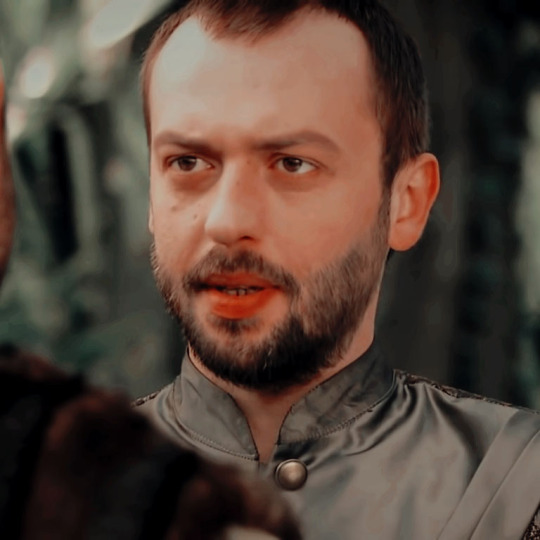




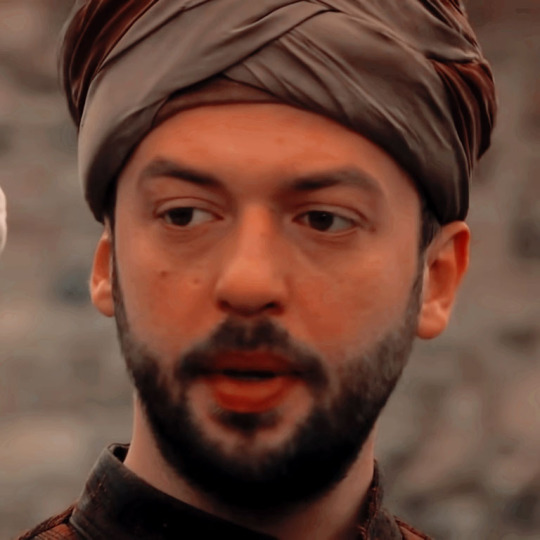



#pargalı ibrahim pasha#pargalı ibrahim pasha icons#icons with psd#psd icons#magnificent century#magnificent century icons#muhteşem yüzyıl icons#muhteşem yüzyıl#actors#actors icons#tv series#tv series icons
4 notes
·
View notes
Photo

Grand Vizier Ibrahim Pasha of Parga (1523-1536). Vezir-i Azam Pargalı İbrahim Paşa (1523-1536). . . . Love history? Become one of our patrons by pledging $1/month and support the historical gems we uncover on a daily basis. http://bit.ly/2CK2tWB #ottomanempire #ottoman #tarih #Allah #syria #palestine #türk #history #İstanbul #islam #osmanlı #photo #photography #photographer #photooftheday #picoftheday #picture #turkey #türkiye #love #painting #paint #ayasofya #malaysia #singapore #indonesia #pakistan #egypt #bosnia — view on Instagram http://bit.ly/2L4xcDB
3 notes
·
View notes
Text
Suleiman
.
ㅤㅤ › 〉 :⸙: .ೃ welcome to: 𝑇𝘩𝑒𝐿𝑎𝑠𝑡𝐷𝑟𝑎𝑔𝑜𝑛 𝑚𝑢𝑠𝑒𝑠 „ ↴
ㅤㅤ ﹀﹀﹀﹀﹀﹀﹀﹀﹀﹀﹀﹀﹀﹀﹀﹀
ㅤㅤ
ㅤㅤ
ㅤㅤ ╰─▸ ❝ #SuleimanTheMagnificent has
ㅤㅤ
ㅤㅤ . . . logged in
ㅤㅤ ㅤㅤ ㅤㅤ ㅤㅤ
ㅤㅤㅤㅤ ㅤㅤㅤ ↺ ' 𝘭𝘰𝘢𝘥𝘪𝘯𝘨... ₊˚.༄ ೃ -
ㅤㅤ
ㅤㅤ
ㅤㅤ ㅤㅤ ㅤㅤ ㅤㅤ . . . . .
ㅤㅤ
ㅤㅤ
ㅤㅤ ① ೃ࿐┊𝐝𝐚𝐭𝐨𝐬 𝐛𝐚́𝐬𝐢𝐜𝐨𝐬 。
ㅤㅤ ㅤㅤ ㅤㅤ ► nombre: Suleiman el magnifico I
ㅤㅤ ㅤㅤ ㅤㅤ ► fandom: Magnificent Century (El Sultán)
ㅤㅤ ㅤㅤ ㅤㅤ ► estatus: Canon
ㅤㅤ ㅤㅤ ㅤㅤ ► as known as: Suleiman, alteza, emperador del imperio otomano, Sultán
ㅤㅤ ㅤㅤ ㅤㅤ ► faceclaim(s): Halit Ergenç
ㅤㅤ
ㅤㅤ
ㅤㅤ ② ೃ࿐┊𝐝𝐚𝐭𝐨𝐬 𝐞𝐬𝐩𝐞𝐜𝐢́𝐟𝐢𝐜𝐨𝐬 。
ㅤㅤ ㅤㅤ ㅤㅤ ► orientación sexual: Heterosexual
ㅤㅤ ㅤㅤ ㅤㅤ ► procedencia: Trebisonda, Turquía
ㅤㅤ ㅤㅤ ㅤㅤ ► ocupación: Sultán del Imperio Otomano
ㅤㅤ ㅤㅤ ㅤㅤ ► residencia: Constantinopla, Turquía
ㅤㅤ ㅤㅤ ㅤㅤ ► habilidades ; personalidad: Suleiman es un hombre de presencia imponente, con una estatura superior a las de sus coetáneos, pero fuera de lo físico, Suleiman era un hombre de temer, en Europa, la sola mención de sus ejércitos causaba pavor a al cristiandad, sin embargo, a pesar de sus reconocidas habilidades para la guerra, que le permitieron ampliar aún más las fronteras de su imperio, en Oriente, Suleiman era conocido por ser un político hábil, astuto, diplomático, calificado como de los mejores estadistas de la época, un hombre inteligente, culto y un estratega nato. El Sultán desarrolló una importante actividad legislativa y reformadora con el propósito de mantener el orden en un imperio en el que convivían más de vente pueblos distintos con diversas religiones. Turquía era uno de los imperios más fuertes, centralizado que estableció por primera vez las relacione diplomáticas regulares con ostros estados. Suleiman era un hombre intransigente en material religiosa, el conjunto de sus leyes resultaba de una aplicación moderada del Corán, además se dedico a reformar la administración civil y militar, bajo los impuestos y no dudaba en destituir, e incluso sentenciar a muerte a aquellos funcionarios que le traicionaban o eran corruptos. Uno de los aspectos de su personalidad fue el amor por la cultura, especialmente le interesaba la historia, las matemáticas, la lectura y escritura de la poesía, la astronomía, y la música. él dedico numerosos poemas a su amada Roxelana, por la cual renunció al harén imperial de Topkapi, que contaba en su época con más de 300 concubinas, y con la cual se casó, un hecho sin precedentes de la dinastía Otomana.
La ciudad de Constantinopla floreció como centro cultural y cosmopolita del mundo conocido y su riqueza y posibilidades atraía como un imán a artistas de todos los territorios en busca de mecenazgo.
Bajo su sultanato se restauraron monumentos, vías de comunicación, y se embellecieron las ciudades. Puede decirse que el esplendor de su imperio le sobrevivió a él durante muchos años gracias a su impulso.
ㅤㅤ
ㅤㅤ
ㅤㅤ ③ ೃ࿐┊𝐝𝐚𝐭𝐨𝐬 𝐞𝐱𝐭𝐫𝐚 。
ㅤㅤ ㅤㅤ ㅤㅤ ►Solimán nació en Trebisonda, la actual Trabzon, seguramente el 6 de noviembre de 1494.
A los 7 años fue enviado a estudiar ciencias, literatura, teología y tácticas militares en las escuelas del Palacio de Topkapı en Estambul. De joven trabaría amistad con Pargalı İbrahim Paşa, un esclavo que más tarde sería uno de sus consejeros de mayor confianza.
A los 17 años fue nombrado gobernador de Estambul, y más tarde de Sarukhan (Manisa), con un breve periodo en Edirne (Adrianópolis).
En el periodo que pasó en Manisa hasta su coronación, ganó experiencia en la administración. Atormentado por los bandidos, restauró la ley y el orden en la provincia, proceso durante el que adquirió la experiencia legislativa que más tarde le daría el nombre de Kanuni o Legislador.A los 26 años –el 30 de septiembre de 1520– heredó el título de califa tras la muerte de su padre Selim I.
Empezó a gobernar el poderoso Imperio otomano, que siguió expandiendo hasta su muerte, 46 años más tarde.
ㅤㅤ
ㅤㅤ
ㅤㅤ ④ ೃ࿐┊𝐫𝐞𝐥𝐚𝐜𝐢𝐨𝐧𝐞𝐬 。
ㅤㅤ ㅤㅤ
ㅤㅤ ㅤㅤ ㅤㅤ ► familiares:
ㅤㅤ ㅤㅤ{♡} Selim I
ㅤㅤ ㅤㅤ ㅤㅤ↳ padre | fallecido
ㅤㅤ ㅤㅤ{♡} Ayşe Hafsa Sultan
ㅤㅤ ㅤㅤ ㅤㅤ↳ madre | personaje no roleable
ㅤㅤ ㅤㅤ{♡} Hatice
ㅤㅤ ㅤㅤ ㅤㅤ↳ Hermana menor | libre
ㅤㅤ ㅤㅤ{♡} Fatma
ㅤㅤ ㅤㅤ ㅤㅤ↳ Hermana menor | libre.
ㅤㅤ ㅤㅤ{♡} Mahidevran
ㅤㅤ ㅤㅤ ㅤㅤ↳ ex consorte, madre del heredero al trono otomano | libre
ㅤㅤ ㅤㅤ{♡} Hurrem Sultán (Aleksandra o Anastasia Lisowska, Rxelana)
ㅤㅤ ㅤㅤ ㅤㅤ↳ Esposa legitima |
ㅤㅤ ㅤㅤ{♡} Şehzade Mustafa
ㅤㅤ ㅤㅤ ㅤㅤ↳ hijo primogénito | libre
ㅤㅤ ㅤㅤ{♡} Mihrimmah Sultán
ㅤㅤ ㅤㅤ ㅤㅤ↳ Primer hija | libre
ㅤㅤ ㅤㅤ{♡} Şehzade Mehmed
ㅤㅤ ㅤㅤ ㅤㅤ↳ Primer hijo varón con Hurrem y favorito de Suleiman | libre.
ㅤㅤ ㅤㅤ{♡} Şehzade Selim
ㅤㅤ ㅤㅤ ㅤㅤ↳ Hijo | libre
ㅤㅤ ㅤㅤ{♡} Şehzade Bayezid
ㅤㅤ ㅤㅤ ㅤㅤ↳ Hijo | libre.
ㅤㅤ ㅤㅤ{♡} Şehzade Cihangir
ㅤㅤ ㅤㅤ ㅤㅤ↳ Hijo | libre
ㅤㅤ
ㅤㅤ ㅤㅤ
ㅤㅤ ㅤㅤ ㅤㅤ ► externas:
ㅤㅤ ㅤㅤ{♡} Pargalı Damat İbrahim Pasha
ㅤㅤ ㅤㅤ ㅤㅤ↳ Mejor amigo | libre
ㅤㅤ ㅤㅤ{♡} Malkoçoğlu Balı Bey
ㅤㅤ ㅤㅤ ㅤㅤ↳ Persona de confianza, comandante militar | libre.
ㅤㅤ
ㅤㅤ
ㅤㅤ ⑤ ೃ࿐┊𝐩𝐥𝐚𝐲𝐥𝐢𝐬𝐭 。
ㅤㅤ ㅤㅤ ㅤㅤ ► Young and beautiful - Lana del Rey
ㅤㅤ ㅤㅤ ㅤㅤ ► Hall of Fame - The Script
ㅤㅤ
ㅤㅤ
ㅤㅤ ⑥ ೃ࿐┊𝐢𝐧𝐝𝐞𝐱 。
ㅤㅤ ㅤㅤ ㅤㅤ► Álbum: https://www.facebook.com/media/set/?vanity=zagreus.maleficent.3&set=a.232887925199910
ㅤㅤ ㅤㅤ ㅤㅤ ► Título del post:
ㅤㅤ
ㅤㅤ
ㅤㅤ ⑦ ೃ࿐┊𝐜𝐫𝐞́𝐝𝐢𝐭𝐨𝐬 。
ㅤㅤ ㅤㅤ ㅤㅤ ► template: __
ㅤㅤ ㅤㅤ ㅤㅤ ► adornos: usuarios ➷ ღ 𝒜́𝓃𝑔𝑒𝓁 y •H en Amino.
ㅤㅤ ㅤㅤ ㅤㅤ ► formato: Wirecode.
ㅤㅤ
ㅤㅤ
ㅤㅤ
ㅤㅤ ╰─▸ ❝ #SuleimanTheMagnificent has
ㅤㅤ
ㅤㅤ . . . logged out

0 notes
Text


Hurrem&Ibrahim secenes (6/?)
#historical costume#historical drama#ibrahim pasha#ibrahim paşa#magnificent century#muhteşem yüzyıl#okan yalabık#pargalı ibrahim#period drama#history drama#hurrem sultan#meryem uzerli
55 notes
·
View notes
Photo

Pargalı İbrahim Paşa camii, Osmanlı dönemi Razgrad, 1840. Ibrahim Pasha mosque, ...
0 notes
Photo

The Ibrahim Pasha Palace, Pargalı İbrahim Paşa Sarayı. Turkish and Islamıc Art Museum, Türk ve İslam Eserleri Müzesi. Sultanahmet Square, Sultanahmet Meydanı. #istanbul #turkey #wanderlust #adventureseeker #doyoutravel #travelmore #goexplore #wonderfulplaces #openmyworld #lovetotravel #adventurethatislife #roamtheplanet #travelbloggers #travelblogging #bloggersofinstagram #tblogger #thattravelblog #bloggerlife #bloggerslife #bloglife #travellifestyle #travelpreneur #digitalnomads #workandtravel #nomadiclife #locationindependent #workhardanywhere #workfromanywhere (Ibrahim Pasha Palace) https://www.instagram.com/p/By9u-9Uh9o6/?igshid=ufa31rjj3yrr
#istanbul#turkey#wanderlust#adventureseeker#doyoutravel#travelmore#goexplore#wonderfulplaces#openmyworld#lovetotravel#adventurethatislife#roamtheplanet#travelbloggers#travelblogging#bloggersofinstagram#tblogger#thattravelblog#bloggerlife#bloggerslife#bloglife#travellifestyle#travelpreneur#digitalnomads#workandtravel#nomadiclife#locationindependent#workhardanywhere#workfromanywhere
0 notes
Text
Piri Reis
Piri Reis (full name Hacı Ahmed Muhiddin Piri - Hajji Ahmed Muhiddin Piri, Ahmed ibn-i el-Hac Mehmed El Karamani; Reis was a Turkish military rank akin to that of captain) was an Ottoman admiral, geographer and cartographer born between 1465 and 1470. He died in 1553.[1]He is primarily known today for his maps and charts collected in his Kitab-ı Bahriye (Book of Navigation), a book that contains detailed information on navigation, as well as very accurate charts (for their time) describing the important ports and cities of the Mediterranean Sea. He gained fame as a cartographer when a small part of his first world map (prepared in 1513) was discovered in 1929 at the Topkapı Palace in Istanbul. His world map is the oldest known Turkish atlas showing the New World, and one of the oldest maps of America still in existence anywhere (the oldest known map of America that is still in existence is the map drawn by Juan de la Cosa in 1500). Piri Reis' map is centered on the Sahara at the latitude of the Tropic of Cancer.[2]
In 1528 Piri Reis drew a second world map, of which a small fragment (showing Greenland and North America from Labrador and Newfoundland in the north to Florida, Cuba, Dominican Republic, Jamaica and parts of Central America in the south) still survives. For many years, little was known about the identity of Piri Reis. His name, roughly translated, means Captain Piri.[4] Today, based on the Ottoman archives, we know that his full name was "Hadji Ahmed Muhiddin Piri"[5] and that he was born either in Gelibolu (Gallipoli) on the European part of the Ottoman Empire (in present-day Turkish Thrace),[6][7] or in Karaman (his father's birthplace) in central Anatolia,[8] then the capital of the Beylik of Karaman (annexed by the Ottoman Empire in 1487). The exact date of his birth is unknown. The honorary and informal Islamic title Hadji (Turkish: Hacı) in Piri's (Hadji Ahmed Muhiddin Piri) and his father's (Hadji Mehmed Piri) names indicate that they had completed the Hajj (Islamic pilgrimage) by going to Mecca during the dedicated period of Hadjj and fulfilling the required rituals.
He was the son of Hadji Mehmed Piri, and began engaging in government-supported privateering (a common practice in the Mediterranean Sea among both the Muslim and Christian states of the 15th and 16th centuries) when he was young, in 1481, following his uncle Kemal Reis,[9] a well-known corsair and seafarer of the time, who later became a famous admiral of the Ottoman Navy.[6] During this period, together with his uncle, he took part in many naval wars of the Ottoman Empire against Spain, the Republic of Genoa and the Republic of Venice, including the First Battle of Lepanto (Battle of Zonchio) in 1499 and Second Battle of Lepanto (Battle of Modon) in 1500. When his uncle Kemal Reis died in 1511 (his ship was wrecked by a storm in the Mediterranean Sea, while he was heading to Egypt), Piri returned to Gelibolu, where he started working on his studies about navigation.
By 1516, he was again at sea as a ship's captain in the Ottoman fleet. He took part in the 1516–17 Ottoman conquest of Egypt. In 1522 he participated in the Siege of Rhodes against the Knights of St. John, which ended with the island's surrender to the Ottomans on 25 December 1522 and the permanent departure of the Knights from Rhodes on 1 January 1523 (the Knights relocated briefly to Sicily and later permanently to Malta). In 1524 he captained the ship that took the Ottoman Grand Vizier Pargalı İbrahim Pasha to Egypt.
In 1547, Piri had risen to the rank of Reis (admiral) as the Commander of the Ottoman Fleet in the Indian Ocean and Admiral of the Fleet in Egypt, headquartered in Suez. On 26 February 1548 he recaptured Aden from the Portuguese, followed in 1552 by the capture of Muscat, which Portugal had occupied since 1507, and the strategically important island of Kish. Turning further east, Piri Reis captured the island of Hormuz in the Strait of Hormuz, at the entrance of the Persian Gulf. When the Portuguese turned their attention to the Persian Gulf, Piri Reis occupied the Qatar peninsula and the island of Bahrain to deprive the Portuguese of suitable bases on the Arabian coast. He then returned to Egypt, an old man approaching the age of 90. When he refused to support the Ottoman Vali (Governor) of Basra, Kubad Pasha, in another campaign against the Portuguese in the northern Persian Gulf, Piri Reis was beheaded in 1553. Several warships and submarines of the Turkish Navy have been named after Piri Reis.
Kitab-ı Bahriye (Book of Navigation): 1521 and 1525
Piri Reis is the author of the Kitab-ı Bahriye, one of the most famous pre-modern books of navigation, including a world map. Although he was not an explorer and never sailed to the Atlantic, he compiled over twenty maps of Arab, Spanish, Portuguese, Chinese, Indian and older Greek origins into a comprehensive representation of the known world of his era.[10] This work included the recently explored shores of both the African and American continents; on his first World Map of 1513, he imprinted the description "these lands and islands are drawn from the map of Columbus."[11] In his text, he also wrote that he used the "maps drawn in the time of Alexander the Great" as a source, but most likely he had mistakenly confused the ancient Greek geographer Ptolemy of the 2nd century AD with the same named General of Alexander (of six centuries before) since his map is similar with the Jan of Stobnica famous reproduction map of Ptolemy, printed in 1512.[12]
The ancient book had been translated in Turkish after a personal order of Mehmed II some decades before.[13] It can be seen that the Atlantic part of the map originates with Columbus because of the errors it contains (such as Columbus’ belief that Cuba was a continental peninsula)[14] since at the time the manuscript was produced, the Spaniards had already been in Mexico for two years. Apart from the maps, the book also contained detailed information on the major ports, bays, gulfs, capes, peninsulas, islands, straits and ideal shelters of the Mediterranean Sea, as well as techniques of navigation and navigation-related information on astronomy, together with information about the local people of each country and city and the curious aspects of their culture. There are thirty legends around the world map, twenty-nine in Turkish and one in Arabic; the latter gives the date as the Muharrem month of 919 AH (corresponding to the Spring of 1513 AD) but most studies have identified the more probable date of completion as 1521.[15][16][17]
It was revised in 1524-1525 with additional information and better-crafted charts in order to be presented as a gift to Suleiman I. The revised edition had a total of 434 pages containing 290 maps. Kitab-ı Bahriye has two main sections, with the first section dedicated to information about the types of storms; techniques of using a compass; portolan charts with detailed information on ports and coastlines; methods of finding direction using the stars; and characteristics of the major oceans and the lands around them. Special emphasis is given to the discoveries in the New World by Christopher Columbus and those of Vasco da Gama and the other Portuguese seamen on their way to India and the rest of Asia.
The second section is entirely composed of portolan charts and cruise guides. Each topic contains the map of an island or coastline. In the first book (1521), this section has a total of 132 portolan charts, while the second book (1525) has a total of 210 portolan charts. The second section starts with the description of the Dardanelles Strait and continues with the islands and coastlines of the Aegean Sea, Ionian Sea, Adriatic Sea, Tyrrhenian Sea, Ligurian Sea, the French Riviera, the Balearic Islands, the coasts of Spain, the Strait of Gibraltar, the Canary Islands, the coasts of North Africa, Egypt and the River Nile, the Levant and the coastline of Anatolia. This section also includes descriptions and drawings of the famous monuments and buildings in every city, as well as biographic information about Piri Reis who also explains the reasons why he preferred to collect these charts in a book instead of drawing a single map, which would not be able to contain so much information and detail.
A century after Piri's death and during the second half of the 17th century, a third version of his book was produced, which left the text of the second version unaffected while enriching the cartographical part of the manuscript. It included additional new large-scale maps, mostly copies of the Italian (from Battista Agnese and Jacopo Gastaldi) and Dutch (Abraham Ortelius) works of the previous century. These maps were much more accurate and depict the Black Sea, which was not included in the original.[18]
Copies of the Kitab-ı Bahriye are found in many libraries and museums around the world: Copies of the first edition (1521) are found in the Topkapı Palace, the Nuruosmaniye Library and the Süleymaniye Library in Istanbul, the Library of the University of Bologna, the National Library of Vienna, the State Library of Dresden, the National Library of France in Paris, the British Museum in London, the Bodleian Library in Oxford and the Walters Art Museum in Baltimore. Copies of the second edition (1525) are found in the Topkapı Palace, the Köprülüzade Fazıl Ahmed Paşa Library, the Süleymaniye Library and the National Library of France.
In popular culture
The Piri Reis maps are mentioned in Erich von Däniken's 1968 bestseller Chariots of the Gods?, Unsolved Mysteries of the Past.
Piri Reis features in Ubisoft's Assassin's Creed: Revelations. In the video game set in 1511 AD, he has taken leave from the Sultan's Navy to work on chart and map making at Constantinople. He is portrayed as a member of the Assassin Order; his greatest contribution to the game is teaching the main character Ezio Auditore how to better use Ottoman bombs.[19]
Piri Reis' maps are referenced in the novel The Space Vampires, in which it states that Reis used extraterrestrial information to increase the accuracy of his maps.
Piri Reis appears in Koei's Uncharted Waters: New Horizons video game. He is a recruitable NPC of Turkish Loyalty and wanders in Turkish ports until either recruited by a player or begins to command a battle fleet for the Turkish navy. His name is spelled Pilly Reis however. He is the highest level and therefore hardest NPC to recruit..
#United States#Topkapı Palace#Piri Reis#Ottoman Empire#Mediterranean Sea#Juan de la Cosa#Istanbul#Hajj
0 notes